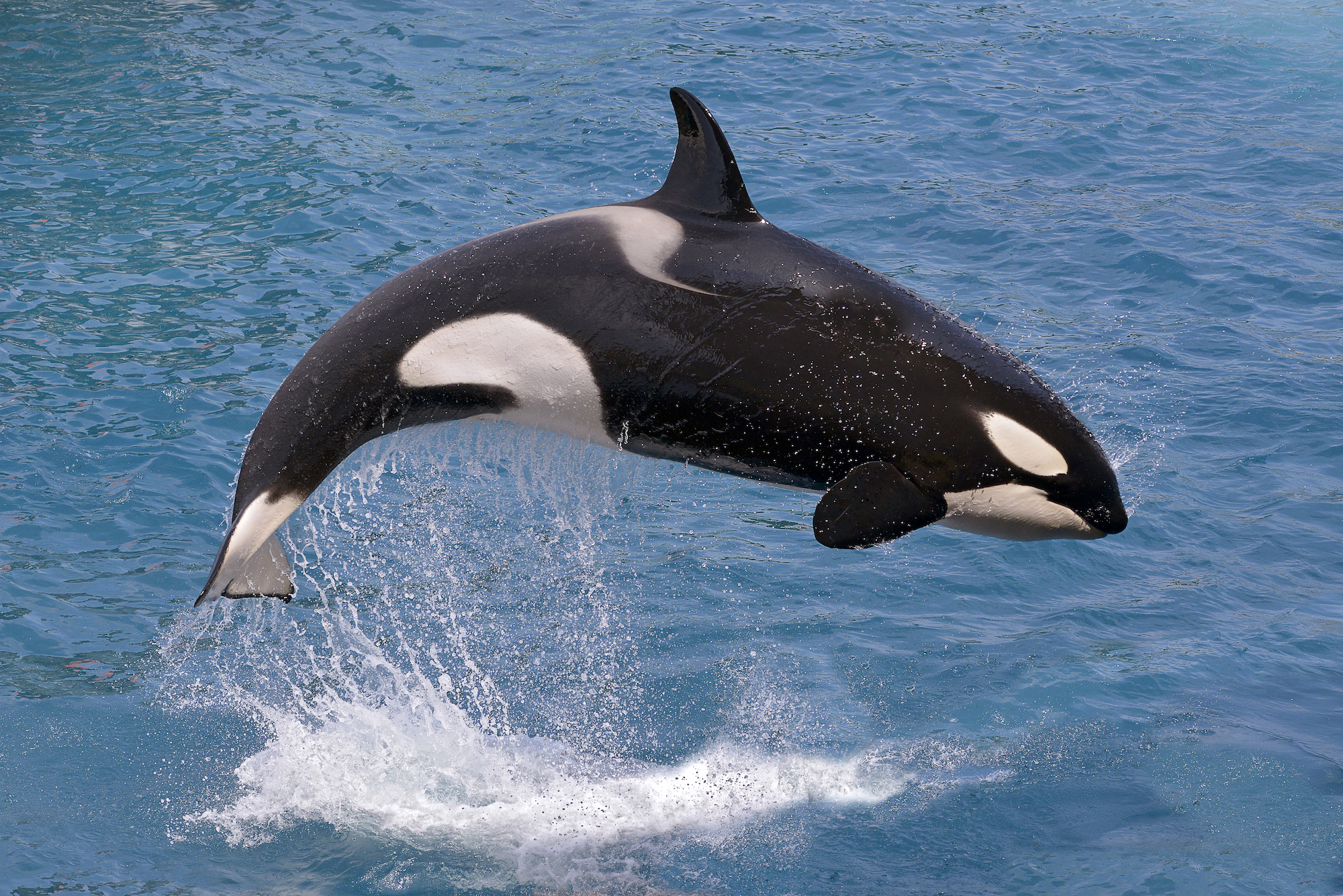12 Killer Whale Facts

Orcas are technically members of the dolphin family, but they’re commonly known as killer whales. You may recognize them by their distinct black-and-white bodies plus their long dorsal fins. And did you know that the largest one on record measured 32 feet long? Read below for 12 killer whale facts to help you better understand this special species.
12 Killer Whales Facts You Need to Know
- Orca whales are commonly known as killer whales. Their name is chosen due to the whale’s ability to attack large marine mammals such as sea lions and other whales. They will prey on nearly any animal they find in the sea, but deter from hunting and attacking humans. The whales use their large 4 inch long teeth to hunt and kill their prey.
- Killer whales are considered the largest species of the dolphin family. The average killer whale size ranges from 23 to 32 feet and weighs 6 tons, nearly the size of a school bus. The largest orca in history was recorded at 32 feet long.
- Orcas have a long dorsal fin and distinct black and white coloring. Orcas are black and white for a specific reason; their prints helps to camouflage them by hiding their outline in the water. Behind the dorsal fin is a patch of gray called a “saddle” due to its resemblance of a horseback riding saddle. An orca’s body is cylindrical and narrows at both ends, forming an aerodynamic shape.
- Other than humans, killer whales are the most widely distributed mammals inhabiting oceans and seas surrounding coastal countries. They can adapt well to almost any climate type, living in the warm waters near the equator or cold polar oceans.
- Killer whales often travel long distances rarely staying in one area at a time. They are most commonly found at higher latitudes and near shorelines.
- Orcas do not travel alone, but in large social groups called pods, containing up to 40 individual members. There are two different types of pods: A resident pod is known to be less aggressive and it prefers fish as prey. Transient pods relate more to the behavior of wolf packs and show more aggression, hunting marine mammals by working together. Orcas use echolocation to talk to each other and hunt. Killer whales also help one another take care of the young in a pod with the young females helping mothers look out for young orcas.
- Killer whales exist at the top of the food chain as apex predators with no other animals hunting orcas other than humans.
- These whales consume sea birds, squids, octopuses, sea turtles, sharks, and fish. Orcas also eat other marine mammals such as seals and dugong.
- Orcas utilize an array of various techniques to catch their prey. Occasionally, they beach themselves to trap and catch seals on land, meaning they jump from the water onto land. They also attack schools of fish in their pods.
- Many may wonder, do killer whales sleep? Yes, they sleep by shutting down one hemisphere of their brain at a time. While half of the killer whale’s brain catches up on sleep, the other half controls the breathing in the body.
- Female killer whales give birth to one offspring at a time every three to 10 years with the gestation period lasting for around 17 months. Their babies are referred to as calves and are about 8.5 feet weighing up to 350 pounds at birth. They nurse for five to 10 seconds at a time, multiple times an hour until they mature to a year.
- The killer whale’s conservation status is unidentified because the world orca population is unknown. Some populations are protected, however, communities around the world kill these whales for a number of reasons. Orcas can be killed for food, by contaminants in the ocean such as chemicals and oil, and by fisherman who deem them as competition to catching fish.
Overview:
Where Do Killer Whales Live?
Orcas can live nearly anywhere in the world. Second only to humans, they’re the most widely distributed mammal species. Killer whales live in warm tropical seas, frigid polar water and everywhere else in between.
What Do Killer Whales Eat?
Orcas are at the top of the food chain. They’re apex predators that typically eat a wide range of other species: marine birds, squid, octopi, fish, sea turtles and even sharks plus smaller sea-dwelling mammals such as seals.
Killer whales capture prey with techniques like beaching, which involves jumping onto land. Another technique involves hunting schools of fish.
Killer Whale Behavior Characteristics
You may have noticed groups of orcas if you’ve ever gone whale watching. Killer whales are social animals, traveling in large groups known as pods. One pod can have up to 40 members.
Orcas communicate with each other using echolocation. They cooperate in many ways, including hunting and raising the pod’s calves. Females gestate the young for about 17 months and give birth every three to 10 years. Younger adult female killer whales in the pod will help the older females look after these calves.
Contrary to common belief, killer whales can sleep in the water. They accomplish this feat by shutting down one brain hemisphere at a time. Unconscious processes like circulation and respiratory remain active while they sleep.
Are Killer Whales Endangered?
Right now, we’re not sure if killer whales are endangered. We don’t yet know how many exist in the world. Unfortunately, they can still be hunted or impacted by marine pollution. Protection efforts by communities worldwide are key to preserving this magnificent species.
